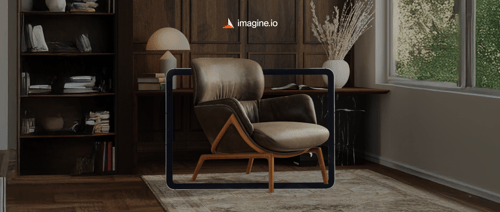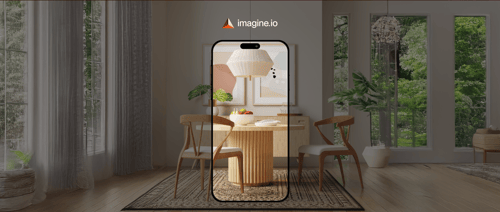In 2024, personalization has become a key focus for many brands. It’s no longer just a trend to customize the product experience for customers - it’s more of a necessity. A McKinsey survey shows that companies that do well with personalization generate as much as 40% more revenue from those activities than the average.
In this blog post we’ll cover exactly what product customization is, how it can positively influence sales, and how to set it up in your eCommerce business.
Get the latest updates straight to your inbox.
By clicking sign up you'll receive occasional emails from imagine.io. You always have the choice to unsubscribe within every email you receive.
What is Product Customization?
Product customization is the process of changing a product in a virtual environment according to the customers’ preferences and interests. This could mean seeing the item in different colors or textures, or with bespoke features. Historically, product customization has always played a crucial role in the customer experience as it’s an important factor in the purchase decision-making process.
Product customization in eCommerce largely mirrors the in-store experience, offering consumers a variety of options to choose from. Imagine a customer is searching online for a sofa – they’d be able to swap the colors out on the fly, place the sofa in a virtual space that closely matches their living room, and see it beside other pieces of furniture they’re interested in. This level of product customization helps alleviate any concerns customers might have about the practicalities of the purchases they make online.
The Evolution of Product Customization in eCommerce
Product customization is nothing new. Since humans started trading, there’s been a desire for made-to-order products that reflect our individual preferences. Mass production was the trend in the 20th century, and consumers had fewer options to choose from. Fast forward to today, and the scales have tipped in favor of product customization. Many consumers now are looking for a rich shopping experience that aligns with their personal tastes.
ECommerce tools have made this easier, as consumers can now cherry-pick the products they want from digital shelves. Solutions like imagine.io allow consumers to visualize their purchase before they reach for the credit card, so they don’t just have to imagine what it would look like in their life.
The Impact of Product Customization on eCommerce Sales
Many companies find that there’s a positive correlation between the level of product customization they offer and their bottom line - most likely because it reflects what consumers of today are looking for. According to Deloitte, 36% of consumers prefer personalized products, so customization represents a huge opportunity for eCommerce growth.
Increased Conversion Rates & Reduced Return Rates
When you allow consumers to tailor products to their preferences, you can give them a unique and memorable shopping experience. Plus, since customers have full control over every facet of the product they’re buying, they’ll be more satisfied with the purchase and less likely to request a return.
Boosted Average Order Value (AOV)
When you offer product customization, you can increase your AOV and reduce the length of your sales cycles. Customers are willing to pay more for personalized products – and you also open the door for upselling opportunities. If you sell jewelry and a consumer buys a custom sapphire necklace, there’s a good chance they’ll want matching bracelets, rings, or earrings to wear with it.
Improved Customer Loyalty and Retention
Relevance is key for effective marketing as an eCommerce business. Grouping your audience into different customer profiles allows you to send promotions and messages that feel relevant to them and their interests. Research from McKinsey shows that on average 25% of revenue for digitally native brands comes from personalized marketing actions and tactics.
Customization is popular among customers because if they can get hands-on with any product they’re interested in, they assume less of a risk with a purchase. A lot of consumers will hesitate to make a purchase online because they “just don’t see it”. By offering immersive product customization, you let them interact with the product and ultimately pave the way for repeat purchases.
Also Read: 10+ Product Customization Examples to Inspire Your Business Strategy
Implementing Product Customization in Your eCommerce Store
The best way to benefit from product customization in your business is to learn best practices for encouraging hands-on interaction with your products.
Tools and Technologies for Product Customization
- Product customizer - A product customizer is a basic tool which allows your customers to change the colors of the product in your eCommerce store or add text to see personalized messages
- Product configurator -
A product configurator is a far more comprehensive tool that allows you to offer complex customization options, so that consumers can see and interact with the product with different features in 3D or in various virtual settings
If you’re looking for a sophisticated solution to offer a high-end product customization experience to your customers, imagine.io offers real-time, interactive product visualizations. As a leader in 3D configurator and customizer technology, it’s a comprehensive solution to plug into your eCommerce store and open up myriad possibilities for consumers.
imagine.io allows integration with the most popular eCommerce platforms, including Shopify and WooCommerce.
Best Practices for Designing Customization Options
While customization can be complex and varied, simplicity is key. To get started, you’ll want to set up your interface to be intuitive for consumers which you can do in several ways:
- Use clear visuals
- Add step-by-step instructions
- Provide real-time previews of changes
In the US, the most common devices used for online purchases are smartphones (73%) so it’s also important to emphasize mobile optimization for any customization features you offer. When designing for mobile, prioritize responsive design, interactive elements that work well on a smaller screen, and fast load times.
Overcoming Challenges in Product Customization
Introducing product customization into your eCommerce store won’t always be a straightforward process. There are various issues and challenges you might encounter along the way, including:
- Load times and performance issues: Adding customization tools to your eCommerce store can slow down your website.
- Compatibility with different eCommerce shop themes: Customization tools won’t always integrate with every eCommerce shop theme or template.
- Managing product variations and inventory: If you introduce lots of product variations and customization options, you might struggle to stay on top of inventory levels.
With imagine.io, you can overcome these common challenges. Our cloud-based platform ensures that your website isn’t slowed down by hosting bulky 3D model files, and integrates customizable configurations directly into your ERP. This allows for streamlined web performance, complete compatibility with store themes, and seamless inventory management.
Industry-Specific Solutions
- Automotive Industry
Customization Features: With 3D configurators you can let your customers choose from a selection of models, colors, trims, and accessories when browsing cars
Benefits: It’s the next best thing from a test drive, and puts consumers in the driving seat as they can apply their preferences before buying.
- Textile Industry
Customization Features: 3D configurators let both designers and consumers see fabric patterns, textures, and colors up close and personal (virtually) and in real time
Benefits: Consumers can visualize fabrics in a range of settings and environments, so they can pick the material that best suits their needs
- Furniture and Home Decor
Customization Features: For the furniture and home decor trades, 3D configurators let consumers can plot out their dream home with realistic visuals
Benefits: By seeing exactly how their new decor will look in their virtual living room, consumers can feel confident in their purchase decision
- Fashion and Apparel
Customization Features: For fashionistas and designers, 3D customizers help them pick out the best fabrics for their projects
Benefits: With this level of personalization, consumers can find products that closely reflect their preferences
- Manufacturing and Industrial Equipment
Customization Features: Configurators allow users to select from a range of machine specifications, configurations, and accessories
Benefits: Customizing machinery streamlines the ordering process and guarantees that any equipment consumers buy will meet their specific operational needs
- Jewelry and Accessories
Customization Features: Using 3D tools, consumers can choose between a selection of gemstones, metals, and custom designs to create unique jewelry pieces
Benefits: No two jewelry pieces need to look the same meaning consumers can create the bespoke piece that they’ve always imagined
The Case for Product Customization
Product customization can be an integral part of your eCommerce growth strategy as it allows you to offer your customers the unique, tailor-made shopping experience research shows they crave.
Elevate your online store with Imagine.io’s full suite of 3D, AI, and AR/VR tools to improve your consumer experience and, in turn, lower your return rate and increase customer loyalty.
Start your 3D configurator journey with imagine.io today!
.gif?width=1296&height=1296&name=Untitled%20design%20(8).gif)




.png?width=500&name=How%20to%20Add%20a%203D%20Product%20Configurator%20to%20Your%20WordPress%20Website%20(Complete%20B2B%20Guide).png)
















%20(1).png?width=500&name=Why%20Exploded%20Mattress%20Views%20Matter%20(And%20How%20to%20Generate%20Them)%20(1).png)
.png?width=500&name=Best%20Shopify%20Product%20Configurator_%20How%20to%20Choose%20the%20Right%20One%20(2).png)
.png?width=500&name=Why%20Exploded%20Mattress%20Views%20Matter%20(And%20How%20to%20Generate%20Them).png)



.png?width=500&name=Best%20Shopify%20Product%20Configurator_%20How%20to%20Choose%20the%20Right%20One%20(1).png)







.png?width=500&name=How%203D%20Rendering%20Can%20Make%20or%20Break%20Your%20Industrial%20Design%20Pitch%20(1).png)








%20with%20Digital%20Twins%20and%203D%20Visualization.png?width=500&name=Optimizing%20Your%20Digital%20Asset%20Management%20(DAM)%20with%20Digital%20Twins%20and%203D%20Visualization.png)




.png?width=500&name=Styling%20Home%20Decor%20for%202025_%20From%20Global%20Influences%20to%20Playful%20Personalization%20(1).png)
